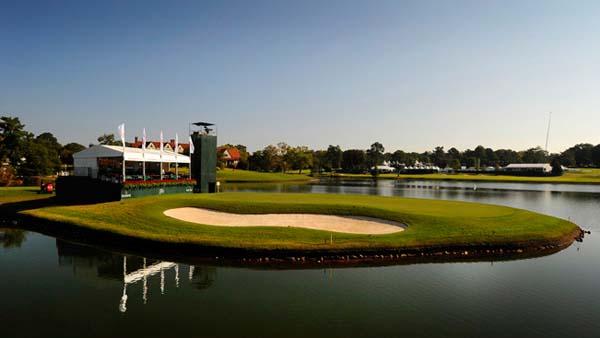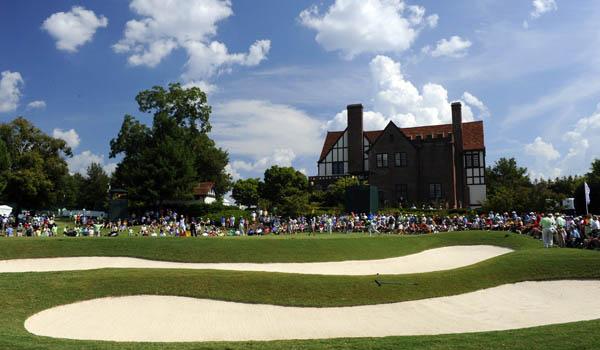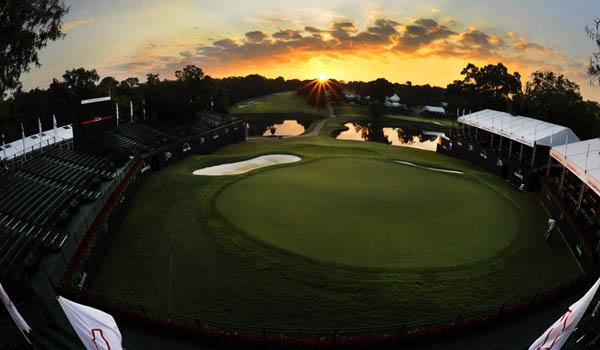-- by Bradley S. Klein, architecture editor for Golfweek.
Under the care of TurfNet member Ralph Kepple for 23 years, East Lake Golf Club in Atlanta, site of this week's Tour Championship, has been the home to the PGA Tour's season finale since 2004.

Founded in 1904 and is Atlanta's oldest golf course, with an original 18-hole layout by Tom Bendelow that subsequently was modified to varying degrees by George Adair, Donald Ross, George Cobb and Rees Jones. It ranks No. 69 on the Golfweek's Best Classic Courses list. The details of its evolution as a club and as a championship stage are entertainingly covered in a newly published book, East Lake Golf Club by Sidney Matthew and Janice McDonald (Arcadia Publishing, 2015).
East Lake, home course of Robert Tyre Bobby Jones, was the scene of the 1963 Ryder Cup and the 2001 U.S. Amateur. It's also more than a fine golf course and club, because it serves as a central element in a unique public/private venture by which the once-deteriorating neighborhood benefits from East Lake's extensive charitable efforts. The current layout is a restored version of a course that had decayed after World War II until Atlanta businessman Tom Cousins rescued the dilapidated facility in the mid-1990s and brought in architect Rees Jones to revive it. Along the way, the club's distinctive Tudor clubhouse also was restored, to the point at which today it is a gathering place for corporate and charitable activities as well as a golf museum.
East Lake is not an especially difficult course. It's devoid of blindness or maddening quirks, though its ideally rolling terrain never quite leaves a level fairway lie. Wind is not much of a factor on this treed, inland site. But the par-3 finishing hole the Greenbrier Classic's TPC Old White offers the only other one on the PGA Tour these days is annually the scene of a dramatic outcome. This year should be no different.
Hole No. 1
Par 4, 424 yards
Straightaway, uncomplicated, into the prevailing breeze out of the west, to a fairway set perpendicular to the contour line. The hole is organized around four natural high points: tee, green and two intermediate rolls in the fairway. Most drives come to rest beyond the second rise in a swale that leaves an uphill approach of about 140 yards to a green bunkered at 4 o'clock and 8 o'clock.
Hole No. 2
Par 3, 214 yards
A perfect medium-length par 3, downhill about 15 feet and down the prevailing wind, across an inconsequential front pond the kind that everyday golfers worry about and that Tour pros never see, much less land in. The shot plays to a modestly sloped green reminiscent in its bunkering of the 11th at St. Andrews a deep bunker front right and another deep hazard flanking the left side. The putting surface, tipped toward the tee and thus receptive of the approach, is divided by a subtle ridge that effectively splits the green. If the hole is cut on the right, the ball can be worked off the slope; if it's cut on the other side, the approach must be from the left. Wind up on the wrong side and face a testy up-and-over long putt.
Hole No. 3
Par 4, 390 yards
With dense trees and out-of-bounds looming the length of the right side, the hole requires a long iron or fairway metal off the tee, past the first bunker at 240 yards on the right, and short of a longer hazard, a pot bunker 300 yards out on the left. With the green perched above the fairway and aligned from front-left to back-right and heavily defended on the right, the ideal line is from the left side, though frankly the approach is so short for these guys that the angles don't matter much, as long as the approach is played from the fairway. The trouble here and elsewhere is trying to play approach shots from Bermudagrass rough thick enough to make spin impossible.
Hole No. 4
Par 4, 440 yards
This is another hole that favors the left side of the fairway, thanks to a pair of fairway bunkers 315 yards to carry along the higher right side and a dense stand of trees flanking the OB there. The elevated green tends to attract shots that fall short, thanks to front bunkers that are foreshortened and a green that tips from back to front.
Hole No. 5
Par 4, 520 yards
Here's a members' par 5 routed at the far southeast end of the golf course that offers a modest reverse-camber effect and tips from high right to low left, while bending toward the right. The west-running hole tends to plays downwind and much shorter than its nominal distance. A low-slung swale across the entrance tends to catch a lot of golf-ball traffic, especially from approach shots played out of the rough.

Hole No. 6
Par 3, 209 yards
This is the country's oldest island par 3 (1907, according to the club's newly published history by Sidney Matthew and Janice McDonald) and surely East Lake's most action-packed hole. The tabletop green is encircled by the club's massive lake and offers one very busy bailout bunker on the left. When the wind's in effect here (quartering, against, from the left) it has a dramatic effect here thanks to the complete exposure of the hole to the elements. A back tee, set far to the right on what is technically the wrong angle, makes the hole extremely awkward to play because the offset axis of approach lines the golfer up over the water and makes a draw difficult to control. It also ends up making players line up far left to hit a left-to-right approach that often gets overcooked and winds up wet. The flat-profile green offers a back-left hole location behind the bunker that is the most inaccessible of any at East Lake. Here's a hole that will decidedly play over par and presents the chance of a real disaster.
Hole No. 7
Par 4, 434 yards
This uphill hole twists around a strategic bunker on the (ideal) right side, 265 yards to reach and 290 yards to fly. A small deep bunker awaits overly bold drives on the inside left of the dogleg, 315 yards to carry, and anything along that left side has a very tight approach path alongside overhanging trees. The safer, more open line to the right of the tee faces a fairway that cuts off abruptly past that right-side bunker into heavy rough and makes it hard to get to this uphill green. The uphill approach into whatever prevailing wind lingers tends to force a more aggressive shot because a very deep greenside bunker blocks the entry.
Hole No. 8
Par 4, 405 yards
This is the only one of East Lake's holes that is not set at a rigid right angle to the holes immediately in front of or behind it. There's no need for a driver here. All that counts is getting the tee shot safely into play on an unusually contoured fairway, with rolling terrain that is a remnant of Civil War-era entrenchments. From there, the short-iron approach has to be precise and with perfect spin onto the hardest green to hold at East Lake. A deep front bunker with a raised edge cuts off incoming shots and makes golfers hit it just a little harder and firmer to make sure they carry. The consequence will be many shots that end up running out long and over. The perched green is the scene of many short-sided recovery shots. It is the most delicate and subtle of East Lake's holes.

Hole No. 9
Par 5, 600 yards
Forget the length here; this will be easily reachable downwind, downhill in two for players who can drive the ball 300-plus yards in the air and reach the downward kick point where the fairway turbo-charges the ball forward. From there, short of the lake that cuts across the fairway at 380 yards off the tee, it's a fairway wood or long iron to a green that will hold a shot slung in on the left side around a bunker that protects the front-right entrance.
Hole No. 10
Par 4, 469 yards
Another converted par 5, this one is heavily bunkered along the length of the fairway on the left side, close to the line best suited for approaching the small green. The putting surface is really designed for a par 5 and thus somewhat elusive to middle irons on a low trajectory. A deep front-right greenside bunker forms a deflective angle that makes approaching on that side very difficult. This forces golfers on the tee to favor the tightly bunkered left side.
Hole No. 11
Par 3, 197 yards
This hole occupies the far northeast corner of the property and plays slightly uphill to a deep green, the rear third of which cannot be seen from the tees. It's also heavily bunkered at 4 o'clock and 7 o'clock, which means that the oncoming middle iron must be perfectly struck or it will bound over into heavy rough, leaving an awkward up-and-over chip shot back for recovery.
Hole No. 12
Par 4, 391 yards
All of a sudden the course loses steam, thanks to the three consecutive par 4s arrayed in a parallel sausage-style. This downhill hole is the most uncomfortable drive of any par 4 at East Lake, thanks to a massive fairway bunker on the right and an overhanging hardwood on the right that cuts off the landing area. Long irons or fairway woods off the tee considerably ease the burden. The approach shot has to carry a steep front bunker that, from the fairway, looks bigger than the green.
Hole No. 13
Par 4, 476 yards
The uphill drive has to trundle through an ominous-looking chute of trees and needs to steer wide right of two expansive fairway bunkers 280 to 330 yards out on the left. The irony here and elsewhere at East Lake is that for all the normal advice of bunker avoidance, players are better off hitting an approach out of the sand than out of the thick Bermudagrass rough.
Hole No. 14
Par 4, 442 yards
Straightaway, slightly downhill, it's tight off the tee to a green with a second tier that makes getting an approach close to the hole difficult, especially out of the rough. From behind the green, as with much of East Lake, par-saving recoveries will go a long way toward determining the winner.
Hole No. 15
Par 5, 525 yards
Now the course kicks into high gear with the first of four stirring and readily memorable holes. The pressure here on the 15th tee is that feeling that a birdie must be made simply to stay abreast of the field. From the low-lying tee, the land here is just crying out for a left-to-right slider played off a deep bunker on the left side such that the land steers the ball safely around two steep fairway bunkers short and right. From there, 210 to 240 yards out from the green, it's an uphill slider to a potato-chip green that's easy to hit but hard to hold if approached through the middle where the waistline is narrowest. There will be many eagles here, with the hole playing under a 4.5 average.
Hole No. 16
Par 4, 481 yards
A dramatic downhill tumbler, with a great view of downtown Atlanta to the west and a clear sense from the tee of a need for a drive hit into the fairway. The right side falls off quickly into woods; the left side progressively narrows from 230 to 320 yards off the tee, thanks to four successive bunkers arrayed scientifically (and mathematically) down the line of play as if with a ruler and laser. Catch the speed slot right center and be left with as little as wedge into this green. Miss the fairway and struggle to keep an approach shot from racing over and down a steep embankment.
Hole No. 17
Par 4, 455 yards
Over the years, the lake on the left side has been brought more into play. Three yawning fairway bunkers 275 to 320 yards off the tee are definitely to be avoided, though that brings water more into play. The raised green, protected up front, kicks everything to the left and toward that water again. Just ask Bill Haas, who in a 2011 playoff with Hunter Mahan made a miraculous recovery on a ball half-submerged, then went on at the next hole to win the FedEx Cup.

Hole No. 18
Par 3, 235 yards
East Lake is one of only a handful of major-venue courses (think Greenbrier's Old White, Pasatiempo and Homestead's Cascades) to end on a par 3. This one will get the players' blood racing because it demands a long iron or rescue to a well-bunkered, small green perched 10 feet above the tee box, though it looks much higher, given the corner of the lake needed to carry. With the world's best players no longer needing to hit long irons into par 4s, the only way to make them hit long clubs into the 18th hole is make them play a stout par 3 such as this one. Unorthodox, but it works.
All East Lake Golf Club photos are by Getty Images.

